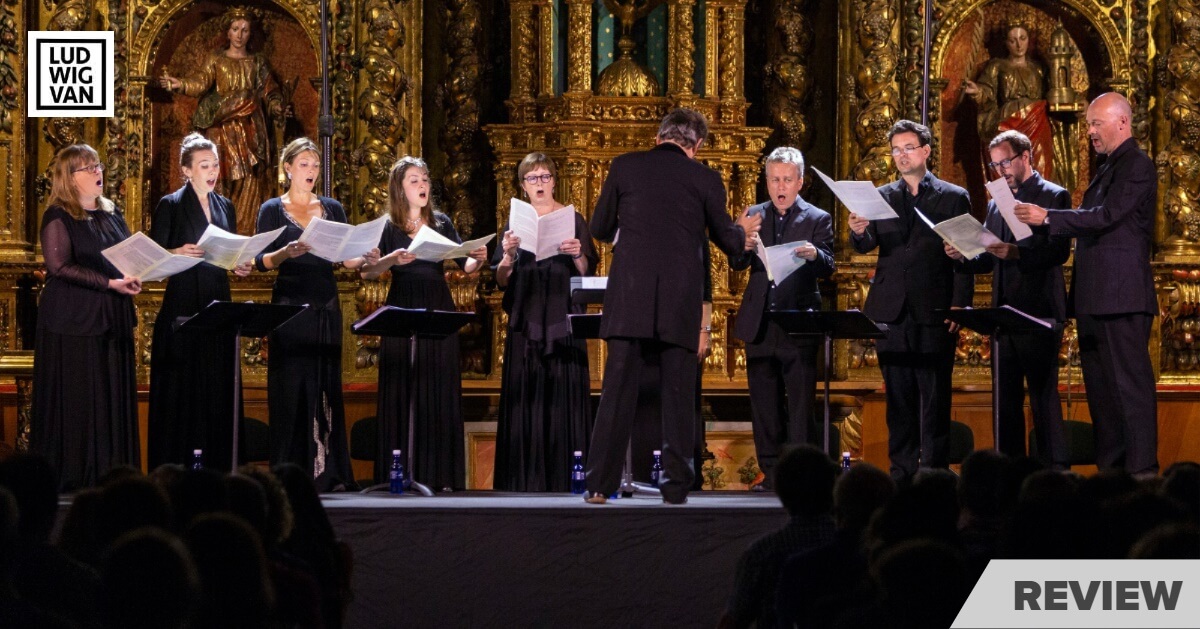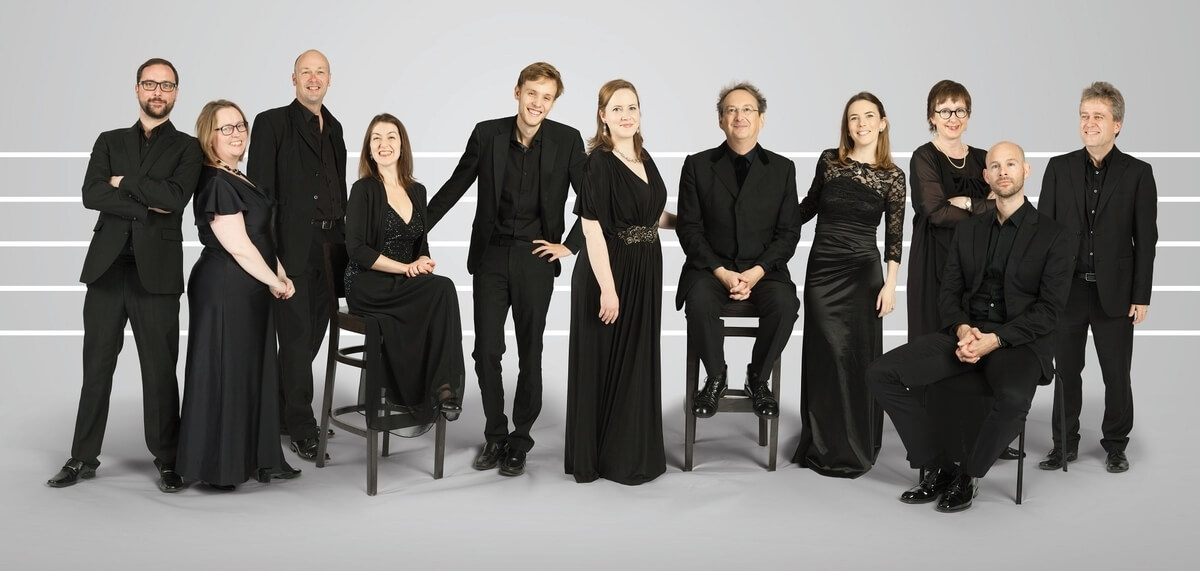The Tallis Scholars impressed a sold-out crowd with an afternoon performance of choral gems at Koerner Hall.

The Tallis Scholars: Reflections; Chant: Salve Regina; Juan Gutiérrez de Padilla: Salve Regina; Francis Poulenc: Salve Regina; William Cornysh: Salve Regina; Chant: Ave Maria; William Cornysh: Ave Maria; Francis Poulenc: Ave Maria; (a 10, arr. Jeremy White); Gregorio Allegri: Miserere; Giovanni Croce: Miserere; Thoma Tallis: O sacrum convivium; Olivier Messiaen: O sacrum convivium; William Byrd: Short Magnificat; Tomás Luis de Victoria: Magnificat for double choir. Saturday, December 8, 2019 at 8 p.m., Koerner Hall.
It was a rare afternoon appearance for the Tallis Scholars when they made their sold-out return performance to Koerner Hall, a quiet Sunday brunch banquet of choral gems short and long, intimate and expansive. The concert of quiet motets and Magnificats was its usual explosive success, receiving an instant standing ovation after the last note (and at the end of their encore, the Bruckner Ave Maria), as though an afternoon of quietude couldn’t be contained for even one moment longer after two hours of the finest music making one could ever expect.
The recital opened with a lovely solo Salve Regina, chanted by tenor Simon Wall, filled with the lyrical grace that has come to be associated with only one of many traditional signature sounds the Tallis Scholars provide in great supply. We were treated to Juan Gutiérrez de Padilla’s motet Salve Regina, set for double choir as the perfect follow-up opener for an afternoon’s display of eloquent compositional craft, with its frequent references to the chant tune and fragmentary takes weaving their way through the composer’s luscious, yet unassuming polyphonic design. In many ways the work was reminiscent of the so-called “Spanish style”, replete with devotional chords set amid a quiet artisanship of carefully controlled points of imitation and lucid, even syncopated, counterpoint.
But for me, the big draw of the first half was the inclusion of two very fine mid-Renaissance works by one of my favourite composers of that era, William Cornysh. We heard both the Salve Regina and Ave Maria mater Dei, two more masterpieces to celebrate alongside his Stabat Mater, which I wish we could have heard live yesterday. If you haven’t picked it up already, I recommend the Tallis Scholars’ remarkable recording project of sacred and secular works by Cornysh, which provides a perfect view of the mid-period style and showcases the composer’s genius admirably well.
Likewise, it was the case with these two motets. Expansive, but intimate, imbued with all the structural and compositional virtues we associate with Henry VII and the Chapel Royal works by John Browne or Robert Fayrfax, the Tallis Scholars own this repertoire like no other group, whether they evince these works’ serenity with consummate professional pacing and intonation, or describe their texts with luscious harmonic colour and a spectral suavity. Regardless, the Tallis Scholars put on a display that is very difficult to duplicate in other ensembles, providing a sound world that borders on a form of auditory hypnotic suggestion. When hearing these works, you don’t want them to end, nor their sounds to expire from your living memory.
Wrapping up the first half, it was a decided pleasure to hear Francis Poulenc’s Marian settings of the Ave Maria (a 10, arranged by Jeremy White) and Salve Regina, both taken from his great 1957 opera Dialogues des Carmélites and cast in a quietly unaffected tonal language. The works are thought to be austere, but more so, they invite images of a deeply personalized devotion and quiet reflection, using mild dissonance to propel the score gently along toward a goal of closer meditation on the texts. Contemporary stylized closeness in voice-leading harmonies translated into immersive contemplative states for the audience, elucidated seemingly effortlessly by the entire ensemble.

Two cherished works which I couldn’t wait to hear in the second half were the settings of O sacrum convivium, presented in novel apposition from versions by Thomas Tallis and Olivier Messiaen.
Tallis’s unique compositional sound and splendid chordal colours, often representing the text through sharp harmonic depictions and bold contours, are best heard as backdrop to the liturgy itself. But, in the concert hall, Tallis’s language takes on a nuanced life of its own, and when counter-balanced with the version by Messiaen, the text leaps to broader life in the hands of this ensemble.
Easily migrating from one intonation system to another, moving from the endarkened world of Tallis’s luxuriant harmonies to the timbral synesthesia of Messiaen, the switch between distant centuries hardly took us by surprise. The stroke of brilliance throughout was the ensemble’s ability to take a word of text, like ‘sacrum’ and sing each new chord setting in a different colour with a different spectrum and a new wash of harmonic light, something like how we imagine Messiaen might have heard the work himself as he composed it. While unabashed in a subdued yet ecstatic light, the ending is an invitation to personal transfiguration, and the Tallis Scholars don’t forfeit one moment of opportunity to paint a new picture for us of a composer’s personalized devotion to an intense fusion with the divine.
The concert ended with William Byrd’s Short Magnificat and the memorable Magnificat for double choir by Tomás Luis de Victoria. Concluding with classic stylistic examples from two of the greats working during the High Renaissance seemed like the best way to finish up the concert. The Tallis Scholars relied firmly on what they have been about for a very long time, presenting the most beautiful works taken from an era perpetually receptive to seamless, serene works designed to prompt the most crystalline of meditations.
The Byrd ‘Short Service’ has been a popular concert staple over the years for the Tallis Scholars but it was still a surprise to hear English after so much Latin. Yet, after a few seconds, it scarcely seemed discontinuous whether on grounds of style or language. Instead, the work sounded all too appropriate, with Byrd’s unique textual rhythms and clarity given with an ease that masked the work’s rich, aesthetic complexity.
For the Victoria Magnificat, dividing ten singers into a sonorous double four-part choir has traditionally worked well in live concert over the years for the Tallis Scholars, and this traditional polyphonic staple of continental Vespers services is a standout among the 18 of Victoria’s output, indeed even among those by Lassus or Palestrina as well.
Leading off the concert’s second half with a splendid performance of Giovanni Croce’s six-voice homorhythmic Miserere, and before it the famous Allegri Miserere, brought it all back for many of us to where it started for the Tallis Scholars, 40 years and some 40 projects ago. The Miserere was the first work they ever recorded, and yesterday afternoon, it sounded even better in Koerner Hall with split ensemble in the left loft and plainchant soloist Simon Wall opposite in loft right, all set in antiphonal style against the main ensemble centre stage.
It is still unusual to me that one of the most penitential pieces of psalmodic singing in falsobordone style should have become a number-one choral hit the world over. The text does not appear to be the focus for contemporary listeners and instead we seem more drawn to the sublimity of the treble’s high C soaring over the acoustic each time it punctuates the meditative polyphonic chanting.
Each performance of the Miserere is simply testimony to the many gifts the Tallis Scholars have imparted over the years. Renaissance polyphony has come to be devotionally important in many more quarters than ever now, thanks in large part to them. But, more so, the Miserere confers a kind of idealized calling card on what Western musical culture’s first Golden Age has to offer, namely a peaceful retreat from the noise of life and an aesthetic need for a tranquility that provides, for even a moment, a wish fulfilled that meaningful answers to the deepest questions of life may be found inside the secret contemplative nexus that is this unique repertoire.
These are the realities of such absorbing performances by the Tallis Scholars, and whether live or recorded, their legions of devoted fans aren’t likely to let the world’s finest ten choristers forget the vital role they have played in their listeners’ lives for the past four decades — and still counting.
#LUDWIGVAN
Want more updates on classical music and opera news and reviews? Follow us on Facebook, Instagram or Twitter for all the latest.
- SCRUTINY | Opera Atelier’s Film Of Handel’s ‘The Resurrection’ A Stylish And Dramatic Triumph - May 28, 2021
- HOT TAKE | James Ehnes And Stewart Goodyear Set The Virtual Standard For Beethoven 250 - December 15, 2020
- SCRUTINY | Against the Grain’s ‘Messiah/Complex’ Finds A Radical Strength - December 14, 2020



